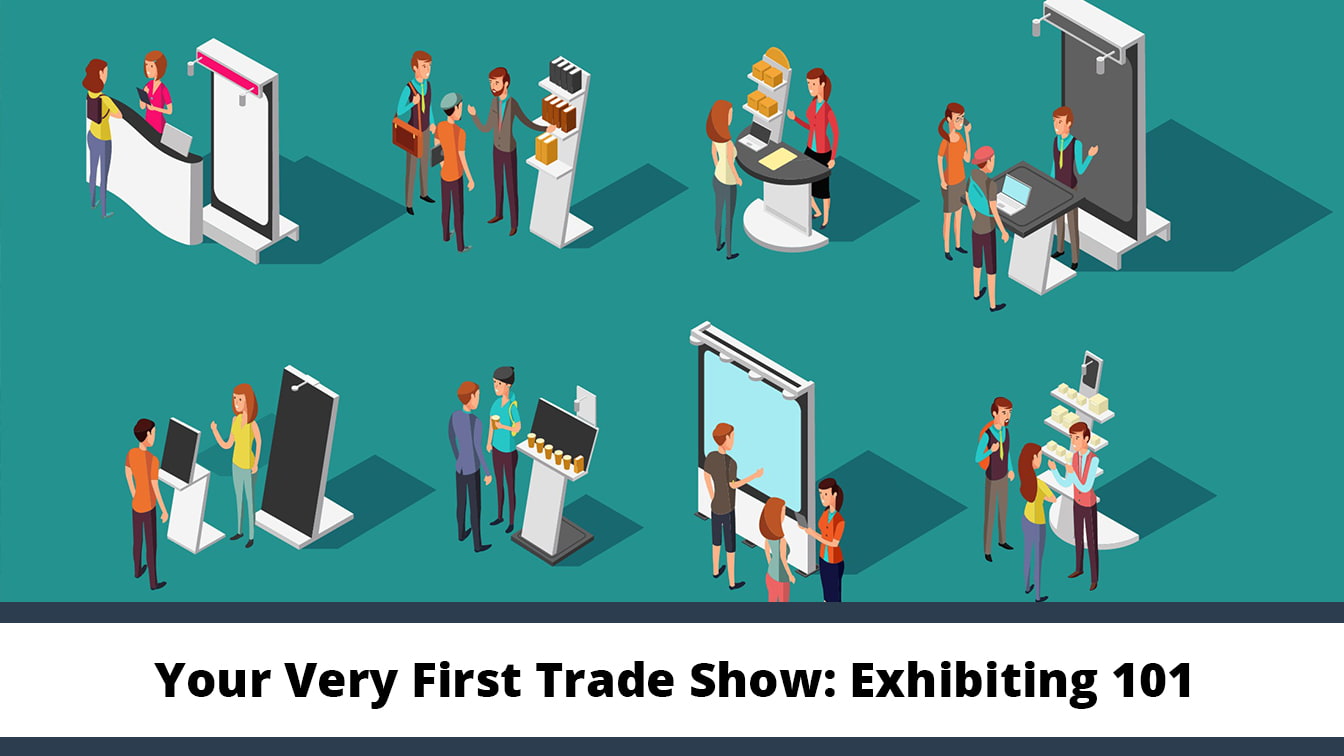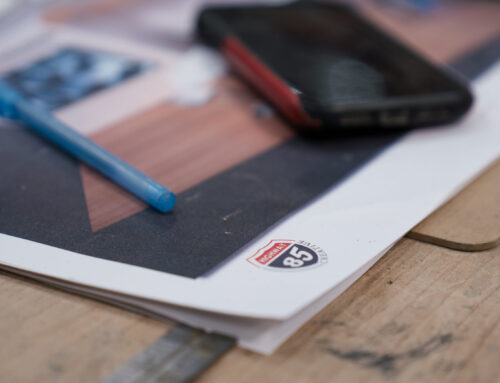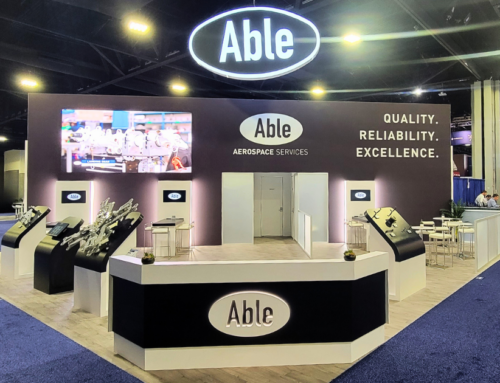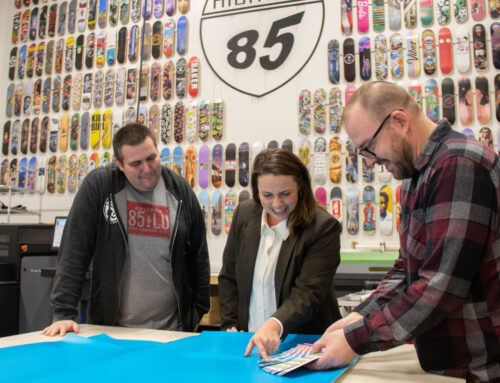Your company is about to participate in your very first trade show and you find yourself feeling excited and a little bit terrified. Don’t worry, this is normal; your first trade show is very exciting but can also feel kind of scary. There is a lot that needs to go into a trade show and sometimes it’s hard to know where to begin, especially if it is your first one. Know that you are not alone and that we’re here to help you navigate trade show chaos.
Where to Begin?
We bet you are wondering where on Earth to begin. There are a lot of different components to planning your trade show experience and once you know where to start and how to plan you will feel much better about it. Keep in mind that exhibiting at a trade show isn’t just renting a booth and showing up, there’s a lot more to it than that. We’ve got some tips for you, and if you follow each one you’ll be prepared to have a successful event.
Plan, Plan, and Plan Some More
Planning is the single most important thing you will do for the trade show you are exhibiting at. Your planning should be very precise and include feedback from all stakeholders that are invested in this trade show. Before you dive into the fine details of your show, you’ll want to establish the goals of the show and how you’ll measure the overall success. Developing a trade show marketing plan can help you with that.
Establish Success Criteria
Most companies will establish success criteria based on the following:
Leads – The amount of leads collected at a trade show will typically be a goal shared between sales and marketing. Leads from trade shows can be tricky because many of them will likely not be qualified if they came by just to get your giveaway item. You want to drive quality traffic to your booth so be careful of glamourous giveaways that take away from your brand and waste time on people that just want a free gift. We’ll go over giveaways in more detail further on in this blog.
Conversions and ROI – Trade shows can be an expensive investment depending on the size and industry. In order for a show to be a success and one that you continue to do, leadership will expect lead conversions with ROI. Depending on industry, you should set a percentage of ROI on your total spend. For first time exhibitors, you may not show any ROI. You’ll want to establish an acceptable miss percentage to determine if the show has the potential to show a return on investment, or if it should be eliminated from your trade show portfolio.
Strategy and Theme – Be sure to have a strategy going into your first trade show. Many companies will go into a show with strategy around new product launches, new product feature releases, and brand awareness to expand the existing customer base. Having a solid strategy will help with your show messaging, booth staffing and giveaways, and ensuring that you are driving quality traffic to your booth.
Once you have established all of your success criteria you should be sure to get final sign off from all invested stakeholders. Make sure everyone is on the same page and clearly understands what the success of the show will be measured upon.
Register as an Exhibitor Now!
This should be the first order of business: the earlier you register, the more time you have to plan. Most show vendors will also offer discounts for registering early. Save on booth space cost and get good deals on sponsorships for even more brand exposure.
You can register for a trade show usually starting a year out all the way up to 2 months before, depending on the show. We strongly suggest you register one year out to take advantage of any early bird discounts and sponsorship opportunities: saving funds here will enable you to increase spending in other areas like booth design.
Registering early will also give you access to select a high traffic location for your booth.Most shows will have a map that will show you the booth locations that are available for you to select, and have you provide a few choices when you register. The early bird always gets the best locations! If you do not want to be shoved in the corner behind a column, then register early.
Communicate with Your Coordinators
Keep the communication flowing and up to date with your coordinators. After the show strategy and plan have been agreed upon and signed off by all stakeholders, be sure to keep them up to date as you progress through each task in the plan. Publish a shared calendar with all show deliverable deadlines and assign owners to each task.
We also suggest setting up a shared network folder or a Dropbox to provide a central location for your show team to share and access critical show documentation and travel information; making sure no one misses any important information or show deadlines. Organization and clear, constant communication with your show team are key to the success of your show.
Be Honest with Your Budget
Your trade show budget is an important part of determining the success of your show, especially at your first trade show. All expenses will be factored into determining any ROI. Account for all costs, from registration fees to display renting costs to staff travel and meals. Most expenses should focus on contributing to the success of the show: things that help drive leads like show sponsorships, logo giveaways, and sales materials to help you promote your brand and drive leads.
Get That Attendee List
Most trade shows you exhibit at will provide you access to the show attendee list to market to. You really want this list and should really consider not exhibiting at shows that are costly and do not provide any access to the attendee list. Many shows will offer a pre and post attendee list in an electronic format with email address only as a method of contact. Others will allow you to send print media through their mailing house or yours.
The attendee list data is also useful in guiding your marketing efforts. This cheat sheet can help you figure out who’s attending and will let you do some pre-show email marketing to specific attendees you see on the list.
Don’t stop at attendee data, be sure to review the full exhibitor list: check out your competition and know where they are located.
Assemble Your Trade Show Team
You can’t successfully run a trade show booth without a team that shares the goals and values of your company. Trade shows cost money, time, and a lot of effort. You want to make sure that when you invest this much into exhibiting, it pays off. A properly trained, positive, and knowledgeable booth staff can gear you towards success. .
The staff you selected to participate in the trade show must be well versed in the company’s products or services. Ready and able to answer questions from attendees. Booth staff should be outgoing and comfortable talking to people and walking the show floor to help drive traffic to the booth. Do not bring the wallflowers that are afraid to talk to people! Get to know who will be staffing your booth prior to the show to make sure the right people are selected
Once you have the right people, make sure you help them be as prepared as possible. Provide an overview of the show strategy that includes everything from the brand messaging, scripts, to required attire. Make sure when you train your booth staff that they understand the goals of the show and success criteria.
Let People Know You’re Going to Be There
You’ve registered to exhibit at a trade show. You have your strategy, plan, and booth staff nailed down. Now, how are attendees going to know you’ll be there if you don’t tell them? You need to tell them through your marketing channels.
Website – Advertise on your website homepage the trade shows you will be exhibiting at. Consider creating a landing page for each show you exhibit at. Be sure to include your booth number and link to the show’s attendee registration pages. You can also include a gated-download to help capture leads in advance of the show.
Email Marketing – Promote your trade show with email marketing campaigns that target your prospects, customers, and pre-show attendee lists to let them know you will be exhibiting at a trade show and get them excited to see you. Be sure to include your booth location and your strategy messaging. Start your email campaigns for your shows as soon as you lock in your strategy.
Paid Media and Retargeting – Set up paid media campaigns and retargeting ads to promote your presence at the show. Be sure to link all media back to the show landing page on your website.
Mailers – Send your prospects and clients postcards announcing your presence at the show. Also include the pre-show attendee list in these mailings if it was provided by the show you are participating in.
Giveaways, It’s What Attendees Want
Just about every attendee that attends a trade show and hits the exhibit floor likes to collect all the free giveaways to take home for their staff, their family, or even themselves. Every attendee that takes your branded giveaway is potentially providing you with an advertising impression every time someone sees this giveaway with your logo on it. They’ve also taken something that will remind them of your brand every time they use it, so make sure they’ll use it again and again to keep your brand top-of-mind.
When selecting your giveaways, pick items that relate to your business: items that your prospects and clients will want to take. We’ve identified some popular trade show giveaway ideas for you to check out here.
Order your branded giveaways with plenty of time to ship to your booth. Ordering the right amount will also be key: you don’t want to run out of giveaway items! If you have a popular giveaway, attendees will be disappointed if you run out early. Show attendee counts are available from the show organizers and are useful in helping you make sure you have enough giveaways.
Design Your Booth
Your booth design should be part of your show strategy. You want to design a trade show booth that evokes emotion while still representing your brand and clearly conveying your strategy for that show.
Quick Pointers for Your Booth
- Make it Memorable – You want your booth to be memorable and stand out from your competitors.
- Be Strategic – Implement your show strategy throughout the design of the booth and think about what your attendees want to see.
- Welcoming – Keep your booth entrance clear of obstruction. Attendees should feel welcomed to enter your booth, not have to go through an obstacle course.
- Use Your Show’s Booth Planning Resources – Follow a trade show booth guide or contact professionals that will help you design a booth that works for you.
For more booth design tips, read our blog on the absolute essential components of an amazing, creative trade show booth.
Booth Sizing
Determining your booth size depends on how the show floor plan is set up, what sizes are available, and your budget.
Many trade shows will have a floor plan available with the booth and floor space that will be available to exhibitors in the exhibit hall. Most will offer a 10×10 or 10×20. Almost any trade show will allow you to go bigger if you want, so if your booth absolutely needs a larger space, it’s very likely you’ll get what you need. Many shows offer off prime floor space that allows for any size booth/display configuration, some even allow for multi-story.
Some trade shows only offer turn-key booths in sizes of 10×10 or 10×20. Those shows will only let you brand your booth and make it really easy to pick because you have limited options. Most smaller shows will offer this option.
Be sure to select the appropriate size for your show budget. For your first show, go for a 10×10 and use your space wisely. If you have a successful first show, upgrade your space the following year. Your goal should be to pull in so much revenue from a trade show that you can build out a large custom space in a few years.
Determine Whether You Should Rent or Not
How do you know whether you should rent a custom display, or purchase a modular display? Some people who purchase a modular display will find that they wish they had gone with a more customized display. If you’re looking for a display that helps you evoke emotion and properly display your brand, you might want to consider a custom exhibit. At the end of the day, everyone has their own needs, and finding a company that can give you highly customized solutions to trade show displays is going to be your best bet.
Figuring out your booth sizing, whether or not you want a custom or modular display, or even how customized you want your booth can be tricky. This is why you want to connect with a company that can help you define your space how you want it. If you’re still confused on the difference between a modular and custom exhibit, or renting in general, you’ll really want to check out our podcast discussing trade show rental tips.
Other Tips to Consider
We’ve talked a lot about planning, budget, booth design and marketing your trade show, but we’ve still got a few other tips for you.
Utilize Technology
Make sure you use technology to help you manage your trade show. Use your smartphone to help you easily plan and stay coordinated with all the moving pieces. Set up calendar reminders for yourself and your team that will remind you of exhibit hall hours, booth staff schedule and other date and time sensitive tasks that your trade show team need to track before and during the show.
Download the show’s mobile app. Many shows offer a mobile app with the show agenda and other show activities. Be sure to have that handy to help you plan booth staffing at peak times.
Ask for Help
Trade shows are not easy, and sometimes the guides they provide don’t quite cut it. Do not hesitate to seek help. If you cannot find what you are looking for in show guides, contact the show organizers for help: they should have a team in place ready to assist you.
If you need answers outside of what show organizers can help with, find a way to network with other event planners who can help you get it all done. Look for event management groups on LinkedIn and other marketing groups that cover topics like trade shows.
Conclusion
Your first trade show is going to be hectic, but if you plan right, and follow the tips in this blog, it can run very smoothly.
Planning and establishing your goals and success criteria with your staff will assist you in identifying what you want to achieve from exhibiting at a trade show.
If you carefully plan everything right and meet your goals and success criteria, you will have had a successful show. Congratulations, now you can start planning the next one!





[…] a look at your last trade show display. How much time and effort did you put into your graphics and graphic design? Did you have […]